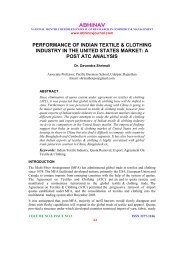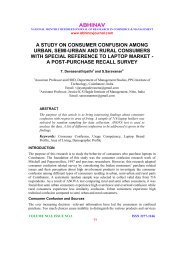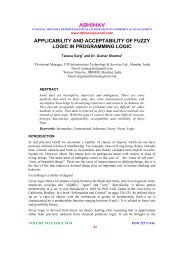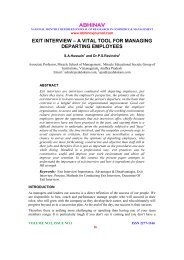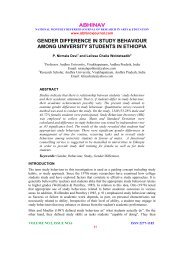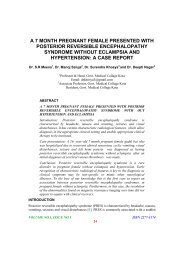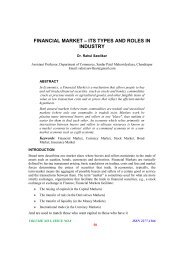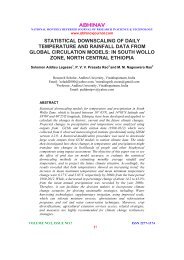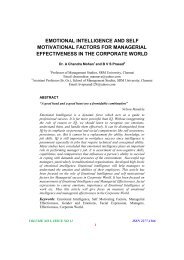A Study On The Importance Of - Abhinav Institute of Management ...
A Study On The Importance Of - Abhinav Institute of Management ...
A Study On The Importance Of - Abhinav Institute of Management ...
Create successful ePaper yourself
Turn your PDF publications into a flip-book with our unique Google optimized e-Paper software.
ABHINAV<br />
NATIONAL MONTHLY REFEREED JOURNAL OF REASEARCH IN COMMERCE & MANAGEMENT<br />
www.abhinavjournal.com<br />
A STUDY ON THE IMPORTANCE OF<br />
WORKPLACE FLEXIBILITY TO MEET<br />
THE NEEDS OF CHANGING WORKFORCE<br />
Dr. Shruti Tripathi 1 and Rashmi Singh 2<br />
1 Assistant Pr<strong>of</strong>essor, Amity University, Noida<br />
Email: callshrutii@gmail.com<br />
2 Research Scholar, Mewar University, Noida<br />
Email: rashmeerai@gmail.com<br />
ABSTRACT<br />
People make choices about how to spend their time as a function <strong>of</strong> both<br />
their personal and work/life needs. For many years, both business leaders<br />
and the public at large have heard anecdotal reports that employees who<br />
are given opportunities to work more flexibly are more dedicated and<br />
productive employees and are better able to manage their lives outside <strong>of</strong><br />
work. Human resource (HR) pr<strong>of</strong>essionals can help their organizations<br />
respond to these transformations by building support for policies and<br />
practices that create effective Workplaces. To be truly flexible and effective,<br />
a workplace—its design, practices and policies—must benefit the<br />
organization and its employees Organizations that provide more effective<br />
and flexible work environments have been shown to have more engaged,<br />
satisfied, and healthier employees with fewer intentions <strong>of</strong> looking for new<br />
employment.. As workplaces become more intense, Organizations find that<br />
they must become more flexible to support employees ineffectively managing<br />
their demands at work and at home and to attract, develop, and retain the<br />
employees they need to succeed. This paper gives an insight as to how<br />
workplace flexibility has impacted the organization in a positive way<br />
INTRODUCTION<br />
Traditional flextime is defined as working a schedule that has start and end times that the<br />
employee has chosen and includes certain core hours determined by the supervisor or<br />
organization. Daily flextime is defined as working a schedule that enables the employee to<br />
vary their work hours on a daily.<br />
SHRM’s Director <strong>of</strong> Research Mark Schmitt shared findings from recent SHRM research on<br />
workplace flexibility in the 21st century.<br />
Highlights from this research include:<br />
VOLUME NO.1, ISSUE NO.12 ISSN 2277-1166<br />
25
ABHINAV<br />
NATIONAL MONTHLY REFEREED JOURNAL OF REASEARCH IN COMMERCE & MANAGEMENT<br />
www.abhinavjournal.com<br />
• HR pr<strong>of</strong>essionals think the biggest investment challenge facing organizations in the<br />
next 10 years will be obtaining human capital and optimizing human capital<br />
investments.<br />
• C-suite executives believe the two biggest challenges facing HR in coming years<br />
will be: 1) retaining and rewarding the best people, and 2) attracting the best people.<br />
• HR pr<strong>of</strong>essionals believe providing flexibility to balance life and work will be one <strong>of</strong><br />
the most effective tactics for attracting and retaining the best people.<br />
• Flexible scheduling is the provision or benefit <strong>of</strong>fered the most by organizations with<br />
the hiring and retention <strong>of</strong> older workers in mind.<br />
• 91% <strong>of</strong> HR pr<strong>of</strong>essionals believe flexible work arrangements have a positive impact<br />
on employee morale (job satisfaction and engagement) and 89% believe employee<br />
retention is positively affected by flexible work arrangements.<br />
• HR pr<strong>of</strong>essionals believe the productivity <strong>of</strong> telecommuters increases and<br />
absenteeism decreases.<br />
• “According to HR pr<strong>of</strong>essionals, the most effective tactic for attracting the best<br />
people and retaining and rewarding the best employees is providing flexibility to<br />
balance life and work.”<br />
• <strong>The</strong> traditional workplace with a nine-to-five schedule is fast becoming a thing <strong>of</strong><br />
the past. This can be attributed to several reasons:<br />
• Technological advances (e.g., PDAs/smart phones, VPN access, virtual<br />
desktops, etc.).<br />
• Increase in global competition/economy.<br />
• Dual-income households.<br />
• Increased number <strong>of</strong> employees with caring responsibilities (e.g., child care,<br />
elder care).<br />
• Varying needs <strong>of</strong> the different generations in the workplace (e.g., employees<br />
under 35 years <strong>of</strong> age tend to value greater workplace flexibility).<br />
Sustainability (e.g., an organization’s ability to balance financial performance with<br />
contributions to the quality <strong>of</strong> life <strong>of</strong> its employees, the local com-munity and society at<br />
large)<br />
Changes all around us, including economic factors, are forcing organizations to re-evaluate<br />
the way they do business and develop alternative approaches to work. Some employers have<br />
turned to flexible work arrangements as one <strong>of</strong> the cost-saving strategies to assist their<br />
employees while at the same time meeting business goals. This study aims at assessing the<br />
flexibility at workplace from Indian context as meeting the needs <strong>of</strong> changing workforce.<br />
VOLUME NO.1, ISSUE NO.12 ISSN 2277-1166<br />
26
ABHINAV<br />
NATIONAL MONTHLY REFEREED JOURNAL OF REASEARCH IN COMMERCE & MANAGEMENT<br />
www.abhinavjournal.com<br />
<strong>Importance</strong> <strong>of</strong> study<br />
An SHRM study, the Workplace Forecast, found that an increased demand for work/life<br />
balance was among the demographic and social trends most likely to have a major strategic<br />
impact on the workplace in the coming years, according to 57% <strong>of</strong> HR pr<strong>of</strong>essionals. In<br />
addition, other demographic and social trends believed to have an impact on the workplace<br />
in the coming years potentially leading to greater demands for work/life balance. In another<br />
study by SHRM, difficulty balancing work/life issues was perceived by HR pr<strong>of</strong>essionals as<br />
a moderate or large threat (41%) to employee retention. It was considered a greater threat to<br />
retention in large organizations than in small and medium organizations. Publicly owned forpr<strong>of</strong>it<br />
organizations were more likely to perceive difficulty balancing work/life issues as a<br />
threat to retention compared with those in the privately owned for-pr<strong>of</strong>it sector.<br />
In light <strong>of</strong> these data, this report examines the flexible work arrangements employers<br />
commonly <strong>of</strong>fer. Also examined in this report are the use <strong>of</strong> these benefits by employees,<br />
challenges associated with flexible work arrangements and factors that make flexible work<br />
arrangements successful, among other topics<br />
A Project on Workplace Effectiveness and Workplace Flexibility, a research-based initiative<br />
to highlight how effective and flexible workplaces can yield positive business results and<br />
help employees succeed at work and at home.<br />
Why do we need flexibility?<br />
Demographic changes in the workplace, requests from employees for more flexibility, and<br />
other trends are increasing the desire for flexible work.<br />
- Technology makes flexible work options possible. Employees can use e-mail, mobile<br />
phones and text messaging, making it easy to communicate anytime, anywhere. <strong>The</strong> Internet<br />
allows remote access to business systems, making it possible to work from home or other<br />
locations.<br />
- Different generational priorities also increase demand for flexible work.<br />
Many Baby Boomers (born between 1946-1964) approaching retirement are deciding to stay<br />
in the workforce past retirement age for financial or personal reasons; the American<br />
Association <strong>of</strong> Retired Persons estimates that 69 percent <strong>of</strong> Baby Boomers will work past<br />
retirement age. Generation Y workers (born from mid-80’s to mid-90’s) are entering the<br />
workforce. Research suggests that this generation has different perceptions <strong>of</strong> work/life<br />
balance and want to pursue personal interests as well as their career.<br />
A meta-analysis <strong>of</strong> 31 flexible work studies found that flexible schedules increased<br />
employee productivity and lowered absenteeism (Baltes, et.al., 1999).<br />
In the National <strong>Study</strong> <strong>of</strong> the Changing Workforce, a study by the Families and Work<br />
<strong>Institute</strong>, 39 percent <strong>of</strong> employees with high availability <strong>of</strong> flexible work arrangements<br />
reported “high levels <strong>of</strong> loyalty and the willingness to work harder than required to help their<br />
employers succeed” (Bond, Thompson, Galinsky, & Prottas, 2002, p. 34).<br />
According to the National Work Life Measurement Project, approximately one-third <strong>of</strong><br />
managers said their work group was more productive because it included employees who<br />
used flexible work arrangements (Fried, Litchfield, & Pruchno, 2003, p. 36).<br />
VOLUME NO.1, ISSUE NO.12 ISSN 2277-1166<br />
27
ABHINAV<br />
NATIONAL MONTHLY REFEREED JOURNAL OF REASEARCH IN COMMERCE & MANAGEMENT<br />
www.abhinavjournal.com<br />
Here are some examples <strong>of</strong> organizations whose flexible work options have had a positive<br />
effect on the organization as a whole:<br />
-A study including Merck, Unilever, Bank <strong>of</strong> Montreal, Starbucks and Baxter International<br />
found that flexible work options led to greater productivity and efficiency and improved<br />
team functioning (Kossek & Hall, 2007).<br />
-Cisco’s telework program resulted in $195 million in increased productivity (Giglio).<br />
-91 percent <strong>of</strong> employees in flexible work arrangements at McGraw-Hill report a positive<br />
impact on productivity (HR Focus, 2007).<br />
- Since the implementation <strong>of</strong> Capital <strong>On</strong>e’s flexible workplace program, there has been a 53<br />
percent increase in employees who say the nature <strong>of</strong> their workplace enhances productivity<br />
(Pomeroy, 2007).<br />
In addition to increased productivity, flexible work options lower employee turnover, which<br />
saves the organization money.<br />
Catalyst, a non-pr<strong>of</strong>it research organization, examined the effects <strong>of</strong> a positive work/life<br />
culture and found a strong correlation with intent to stay at a company (Catalyst, 2005).<br />
In the National <strong>Study</strong> <strong>of</strong> the Changing Workforce, 73 percent <strong>of</strong> employees with<br />
high availability <strong>of</strong> flexible work arrangements said they would stay with their<br />
current employer for the next year (Bond, Thompson, Galinsky, & Prottas, 2002).<br />
Best Buy has seen a 90 percent reduction in employee turnover in departments that<br />
have implemented ROWE (Jossi, 2007).<br />
Deloitte reports they have saved $41.5 million in turnover costs since implementing<br />
flexible work options (Corporate Voices, 2005).<br />
<strong>The</strong> employee retention rate in Aflac’s call center operations has gone from 87<br />
percent to 94 percent (Giglio).<br />
Flexible work options reduce the number <strong>of</strong> commuters on the roads. Employees on<br />
compressed workweeks and part-time schedules commute less; telecommuting eliminates the<br />
commute entirely. Fewer commuters helps the environment.<br />
Parents with flexible work schedules feel they are more involved in their children’s<br />
lives and can better meet their family obligations. Conversely, parents who are able<br />
to manage their households will be better able to focus on work.<br />
Flexible work options support the community. Parental involvement is important for<br />
schools. Employees with flexibility may be more likely to be involved in volunteer<br />
organizations in their communities.<br />
A Deloitte study found that 91 percent <strong>of</strong> participants agreed that workers were more<br />
likely to behave ethically when they had a good work/life balance. When employees<br />
are dissatisfied with their work, they are more likely to rationalize inappropriate<br />
behavior; however, if they are satisfied with work, they tend to be more honest. This<br />
is good for both the organization and society as a whole (Gurchiek, 2007).<br />
VOLUME NO.1, ISSUE NO.12 ISSN 2277-1166<br />
28
ABHINAV<br />
NATIONAL MONTHLY REFEREED JOURNAL OF REASEARCH IN COMMERCE & MANAGEMENT<br />
www.abhinavjournal.com<br />
OBJECTIVES OF THE STUDY<br />
1. To know whether the organizations <strong>of</strong>fer provisions for Flexible Work<br />
Arrangements.<br />
2. To know whether these arrangements are <strong>of</strong>fered to all/few employees.<br />
3. To know whether the flexibility program is more formal (written policy, employee<br />
request forms, approval channels, etc.) or Informal (no written policies or forms,<br />
discretion <strong>of</strong> manager, etc.)<br />
4. To understand the reasons that prompted organization to <strong>of</strong>fer Flexible Work<br />
Arrangements<br />
RESEARCH METHODOLOGY<br />
Sample size<br />
Organization type Sample size<br />
Small (1–99 employees) 50<br />
Medium (100–499 employees) 30<br />
Large (500 and more employees) 20<br />
Total 100<br />
Sampling Technique: Convenience Sampling<br />
Data collection procedure<br />
<strong>The</strong> data for this research would be collected both from primary as well as secondary<br />
sources.<br />
Primary sources<br />
Questionnaire Method: <strong>The</strong> questionnaire in printed form would be sent to the superiors as<br />
well as the subordinates with a request to fill it. <strong>The</strong>re would be a systematic and particular<br />
question sequence.<br />
Secondary sources<br />
FINDINGS<br />
Publications <strong>of</strong> the organization<br />
Magazines and journals<br />
<strong>The</strong> survey provided a clear message that the vast majority <strong>of</strong> IT companies have now<br />
established a range <strong>of</strong> flexible working practices:<br />
• 88% <strong>of</strong> those businesses surveyed now provide some form <strong>of</strong> flexible working<br />
initiatives<br />
• 41% <strong>of</strong> organizations also have a formal flexible work practice policy in place<br />
VOLUME NO.1, ISSUE NO.12 ISSN 2277-1166<br />
30
ABHINAV<br />
NATIONAL MONTHLY REFEREED JOURNAL OF REASEARCH IN COMMERCE & MANAGEMENT<br />
www.abhinavjournal.com<br />
This is an encouraging sign and would illustrate that at a strategic level employers have<br />
embraced the changing expectations <strong>of</strong> the workforce around the area <strong>of</strong> work-life balance<br />
and the move away from ‘traditional’ working practices.<br />
Advancements in technology have no doubt contributed to this mindset change.<br />
<strong>The</strong> survey results resonated with the message that the cultural, behavioral and business<br />
benefits <strong>of</strong> flexible work practices were clearly understood:<br />
• <strong>On</strong>ly 2% <strong>of</strong> the surveyed audience felt that there were no positive business benefits<br />
gained from introducing flexible work practices<br />
<strong>The</strong> range <strong>of</strong> benefits that surveyed audience felt flexible practices produced were extensive<br />
and included:<br />
• 56% felt flexibility would create higher levels <strong>of</strong> retention<br />
• 53% also felt employee morale would increase<br />
• 47% <strong>of</strong> all respondents believed that employee engagement would improve<br />
• 32% felt they would reduce absenteeism in the workplace<br />
<strong>The</strong>se insights therefore tell a positive picture <strong>of</strong> a maturing business environment and a high<br />
acceptance level <strong>of</strong> the need to develop and make available flexible working methodologies.<br />
Training and retention<br />
As well as examining the current levels <strong>of</strong> corporate flexibility the survey also explored how<br />
flexible work practices are currently being used to both retain and attract talent.<br />
When these questions were asked, some interesting results were produced:<br />
• 76% had not received any formal training or advice on how to manage flexible work<br />
requests.<br />
• 51% <strong>of</strong> current flexible practices were introduced as a retention tool<br />
• 56% agreeing that flexible work practices would have a positive effect on staff<br />
retention.<br />
For the managers on the front line tasked with building, developing and retaining productive<br />
teams understanding and communicating these business benefits remains an issue.<br />
It would appear that managers also remain unsure how to promote flexible arrangements or<br />
deal with requests when they are received.<br />
Flexibility as a recruitment tool<br />
Connecting flexibility to the organizational Employee Value Proposition (EVP) was another<br />
area <strong>of</strong> the survey which produced interesting results:<br />
56% <strong>of</strong> respondents agreeing that flexible work practices would have a positive benefit in<br />
attracting quality staff.<br />
VOLUME NO.1, ISSUE NO.12 ISSN 2277-1166<br />
31
ABHINAV<br />
NATIONAL MONTHLY REFEREED JOURNAL OF REASEARCH IN COMMERCE & MANAGEMENT<br />
www.abhinavjournal.com<br />
<strong>The</strong> clear message here for organizations is to work harder to ensure the flexible benefits<br />
already available are fully integrated into the recruitment process when the business is being<br />
promoted to potential employees.<br />
As we move into a new era <strong>of</strong> engagement between employee and employer, perhaps<br />
flexibility needs to have a bigger part to play in the day to day engagement between the<br />
organisation and its current and future talent.<br />
<strong>The</strong> survey results have revealed a number <strong>of</strong> both positive and negative findings around the<br />
development, acceptance and integration <strong>of</strong> flexible working practices in the Indian IT<br />
industry.<br />
• 88% <strong>of</strong> organisations currently provide some form <strong>of</strong> flexible work practices<br />
• 41% <strong>of</strong> organisations have a formal flexible workplace policy in place<br />
• 56% believe flexible work practices will have a positive effect on staff retention<br />
• 44% <strong>of</strong> staff do not know or the respondents were unsure <strong>of</strong> their staff’s knowledge<br />
<strong>of</strong> available flexible benefits<br />
• 76% <strong>of</strong> those surveyed had not received any training or advice on the topic<br />
<strong>The</strong> findings from this research show that formal FWAs have a positive impact on both<br />
employees and employers. <strong>The</strong> quality <strong>of</strong> employees’ personal/family life is positively<br />
affected as a result <strong>of</strong> implementing flexible work arrangements, according to two-thirds <strong>of</strong><br />
HR pr<strong>of</strong>essionals (68%).<br />
• 91% percent <strong>of</strong> HR pr<strong>of</strong>essionals believe implementation <strong>of</strong> formal FWAs had a<br />
positive impact on employee morale (job satisfaction and engagement).<br />
• Retention <strong>of</strong> employees (89%) was also reported to have been affected positively by<br />
the implementation <strong>of</strong> flexible work arrangements.<br />
• <strong>The</strong> most common obstacle organizations experienced with formal FWAs is<br />
suitability <strong>of</strong> job for flexible work (i.e., the type <strong>of</strong> work performed by an employee).<br />
<strong>On</strong>e in three (36%) HR pr<strong>of</strong>essionals cited business needs as a constraint to FWAs.<br />
Publicly owned for-pr<strong>of</strong>it organizations (39%) are more likely to experience this<br />
obstacle than nonpr<strong>of</strong>it organizations (18%).<br />
• Companies with formal FWAs have seen increased productivity rates <strong>of</strong><br />
telecommuters at their organizations and a drop in absenteeism.<br />
• In its widest context, workplace flexibility is now an established part <strong>of</strong> our working<br />
environments.<br />
Other positive business benefits that can be gained from introducing flexible work practices<br />
• More motivated/committed individuals<br />
• Employees seem to be happy to come to work<br />
VOLUME NO.1, ISSUE NO.12 ISSN 2277-1166<br />
32
ABHINAV<br />
NATIONAL MONTHLY REFEREED JOURNAL OF REASEARCH IN COMMERCE & MANAGEMENT<br />
www.abhinavjournal.com<br />
• Females/mothers will stay in the workplace<br />
• Assisting in bringing people back into the industry that left as they could not manage<br />
working a full time role but could work part time<br />
• Word <strong>of</strong> mouth. Current employees will pass on the message about the flexible<br />
conditions <strong>of</strong> our workplace<br />
Other potential negative outcomes that flexible work practices may produce<br />
• Employees seeing this as an entitlement and not a privilege<br />
• Balancing out the need for flexibility <strong>of</strong> an employee against the needs <strong>of</strong> the<br />
business<br />
• Difficulty in managing team culture and dynamics<br />
• Continuity <strong>of</strong> work within teams<br />
• Decreased communication – Teamwork may be affected<br />
• Lots <strong>of</strong> wasted time due to handovers<br />
• Potential negative reaction from older workers who may have missed out on some<br />
benefits<br />
• In projects I believe knowledge transfer will be an issue<br />
• People who are not entitled may have to increase output to cover<br />
Is <strong>The</strong>re Workplace Support For Flexibility?<br />
Although we find that the vast majority <strong>of</strong> employees want to use more flexible work<br />
options if there were no repercussions, we also find that many employees believe<br />
that there are, in fact, negative consequences for working flexibly.<br />
Overall, 27 percent <strong>of</strong> respondents agree that there is job jeopardy for working<br />
flexibly. This jeopardy may come from employers who <strong>of</strong>fer flexibility and then<br />
penalize its use.<br />
Managing more flexibly and working more flexibly place new responsibilities on<br />
both managers and employees.<br />
Optimal flexibility will not be the same for every employer or employee. Solutions<br />
must be tailored to the operational needs <strong>of</strong> each organization and adjusted to fit the<br />
roles, needs, and abilities <strong>of</strong> different employees to accept the responsibilities<br />
required for working flexibly.<br />
Despite the common perception that flexibility is primarily for employed mothers<br />
and parents, when flextime is <strong>of</strong>fered most <strong>of</strong> the non-parents use it. Men and<br />
women, parents and non-parents, employees with and without elder care<br />
VOLUME NO.1, ISSUE NO.12 ISSN 2277-1166<br />
33
ABHINAV<br />
NATIONAL MONTHLY REFEREED JOURNAL OF REASEARCH IN COMMERCE & MANAGEMENT<br />
www.abhinavjournal.com<br />
responsibilities, employees at different earnings levels, managers/pr<strong>of</strong>essionals are<br />
equally likely to want more flexible work options.<br />
As with any social or economic change, the transformation to a more flexible<br />
workplace has not always been easy or smooth. Most significant is the perceived<br />
“penalty” for using flexibility with 27 percent believing this to be the case.<br />
As times are changing, that working with flexibility will become as commonplace as<br />
working with technology. Thus, it is incumbent on us to continue to design new<br />
ways <strong>of</strong> working that benefit both employers and employees.<br />
Flexible work will continue to be a focus for successful organizations. Creative<br />
employees and companies will continue to find flexible ways to work. Further,<br />
flexible work initiatives will likely become organizational “must-haves” as more<br />
employers and employees discover the benefits <strong>of</strong> flexible work.<br />
Potential Solutions<br />
Changes to management practices to successfully implement Flexible Work Practices<br />
• Managers will need to be trained in managing from a distance e.g. how to measure<br />
performance or targets. Remote communications. Also how to build team spirit etc<br />
when team is located at different sites or only comes together on occasion<br />
• Recruitment <strong>of</strong> the right type <strong>of</strong> staff with the right attitude. Recruitment agencies<br />
will need to play a bigger role in recognizing and balancing the needs <strong>of</strong> the business<br />
and the candidate<br />
• Developing clear guidelines/policy around the application <strong>of</strong> workplace flexibility<br />
and the approval process<br />
• Manpower/resource planning will alter, managers will need to be more skilled and<br />
creative in dealing with requests for flexibility and finding workable solutions<br />
• Increases monitoring as you need to ensure your work force is being productive at<br />
home<br />
• Loss <strong>of</strong> team dynamics when employees are not visible<br />
Telecommuting is becoming a popular option for employers because <strong>of</strong> advancing<br />
technology. <strong>The</strong>re are certain jobs that would not be suitable for telecommuting. Positions<br />
that require a lot <strong>of</strong> interaction with other employees may make telecommuting a challenge.<br />
Telecommuters must be self-motivated and able to work independently. <strong>The</strong>y must also be<br />
focused and not be easily distracted.<br />
Networking can support flexible workers<br />
• <strong>The</strong>y can trade tips on working in flexible work arrangements.<br />
• <strong>The</strong>y can learn how to structure their work in a flexible arrangement.<br />
• <strong>The</strong>y can get advice when problems occur.<br />
VOLUME NO.1, ISSUE NO.12 ISSN 2277-1166<br />
34
ABHINAV<br />
NATIONAL MONTHLY REFEREED JOURNAL OF REASEARCH IN COMMERCE & MANAGEMENT<br />
www.abhinavjournal.com<br />
During economically challenging times, when many organizations are searching for ways to<br />
cut costs, FWAs—for example, job-sharing or part-time positions—may be an alternative to<br />
downsizing through lay<strong>of</strong>fs.<br />
Including line managers in the design <strong>of</strong> FWAs creates buy-in. Line managers who do not<br />
understand their organizations’ FWAs policy and program may have a negative impact on<br />
how FWAs are administered within the organization. <strong>On</strong>e-third <strong>of</strong> organizations saw<br />
inconsistency in policy and program implementation as one <strong>of</strong> the obstacles to FWA<br />
programs.<br />
Communication between line managers and their direct reports is vital to the success <strong>of</strong> an<br />
organization’s FWAs. Open communication helps line managers under-stand their direct<br />
reports’ needs. This will assist the managers in suggesting and supporting FWAs that best<br />
meet both the employer’s and employees’ needs.<br />
Creating a flexible work culture where employees know that management wants them to<br />
succeed at work and in their personal lives will help employers design and implement<br />
effective FWAs that are mutually beneficial.<br />
(i)<br />
(ii)<br />
If adequate information is not available to demonstrate the value <strong>of</strong> a program to<br />
the organization, that program may not get the support <strong>of</strong> top management.<br />
Organizations can use easy-to-administer tools such as employee surveys to<br />
measure their program participation rate and employee satisfaction with the<br />
program.<br />
It is worth stating the obvious, many <strong>of</strong> the benefits <strong>of</strong> having flexibility initiatives depend<br />
on employees using them. Periodically, employers should consider new ways to “remind”<br />
employees <strong>of</strong> the availability <strong>of</strong> existing initiatives and sharing success stories <strong>of</strong> employees<br />
who use available flexible work options<br />
Employees and managers agree that using flexible work arrangements have positive impacts<br />
on productivity and quality <strong>of</strong> work, regardless <strong>of</strong> the type <strong>of</strong> flexible work arrangement<br />
used.<br />
<strong>The</strong>y also agree that employees using telecommuting are more likely to have poor<br />
relationships with co-workers, less likely to get the same salary increases, and less likely to<br />
get coworker support than employees using flextime... A new balance needs to be achieved<br />
between work and home for working families. Our social worlds have changed; working<br />
families are the human face <strong>of</strong> the American workplace. Bringing work and family life into a<br />
more reasonable alignment requires a new configuration <strong>of</strong> work that meets the needs <strong>of</strong><br />
businesses and families. Workplace flexibility is not an option but a critical need <strong>of</strong> working<br />
families and the businesses in which they work.<br />
Creating a flexible workplace<br />
• Identify the environmental, societal and demographic trends that are causing an<br />
increased demand for flexible work options.<br />
• Understand how flexible work options can benefit an organization and support an<br />
organization's strategy<br />
VOLUME NO.1, ISSUE NO.12 ISSN 2277-1166<br />
35
ABHINAV<br />
NATIONAL MONTHLY REFEREED JOURNAL OF REASEARCH IN COMMERCE & MANAGEMENT<br />
www.abhinavjournal.com<br />
• Identify flexible work options and other employee policies, programs and benefits<br />
employers can <strong>of</strong>fer to support a flexible workplace.<br />
• Understand the process <strong>of</strong> designing and implementing flexible work options.<br />
REFERENCES<br />
1. R. Baral, S. Baral “HR interventions for work-life balance: evidences from organisations<br />
in India”International Journal <strong>of</strong> Business, <strong>Management</strong> and Social Sciences Vol. 2, No.<br />
1, 2011, pp. 33-42<br />
2. Carol Upadhya and A.R. Vasavi “Work, culture, and sociality in the Indian IT industry:<br />
a sociological study, indo-Dutch Programme for Alternatives in Development” by<br />
School <strong>of</strong> Social Sciences National <strong>Institute</strong> <strong>of</strong> Advanced Studies Indian <strong>Institute</strong> <strong>of</strong><br />
Science Campus<br />
3. Baird, M. and Williamson, S., (2009) “Women, work and industrial relations in 2008”<br />
Journal <strong>of</strong> Industrial Relations 51:3 331 - 346<br />
4. Beauregard, T. and Henry, L “Making the link between work-life balance practices and<br />
organisational performance” Human Resource <strong>Management</strong> Review . (2009) 9 -22<br />
5. Belfast “Flexible Working and Time to Train: Response to Public Consultation<br />
Department for Employment and Learning” Department for Employment and Learning<br />
(2010)<br />
6. Harr, J “Work-Life Balance in a Recession: Do Employees Still Care?” Waikato<br />
University: Hamilton. Presentation to HRINZ Conference May 2010 downloaded on 20<br />
August 27, 2012 http://929.hrinz.org.nz/Site/ events_national/<br />
929_home/929/Presentations.aspx<br />
7. Andrew Liakopoulos, Anne Weisberg, Deloitte Consulting LLP<br />
aweisberg@deloitte.com<br />
8. Seth Siegel, et al “Why Change Now? Preparing for the Workplace <strong>of</strong><br />
Tomorrow”(Deloitte, 2009 )<br />
9. Sue Shellenbarger “<strong>Of</strong>fice Workers, How Long Before You Hit the Breaking Point?” by,<br />
<strong>The</strong> Wall Street Journal, June 3, 2010.<br />
10. <strong>The</strong> New Career Paradigm: Attracting and Retaining Critical Talent (American Business<br />
Collaboration, 2006)<br />
11. When Work Works: A Project on Workplace Effectiveness and Workplace Flexibility.”<br />
Initiative partners include the Center for Workforce- Preparation an affiliate <strong>of</strong> the U.S.<br />
Chamber <strong>of</strong> Commerce and <strong>The</strong> Center for Emerging Futures.<br />
12. Wallace E. “Measuring the impact workplace flexibility” Boston College Center for<br />
work & family Carroll School <strong>of</strong> <strong>Management</strong><br />
13. “<strong>The</strong> 2010 SHRM Executive Roundtable on Workplace Flexibility” A Conference that<br />
was held Sept. 23, 2010, in Washington D.C<br />
14. “Survey on Workplace Flexibility”A report by World at Work February 2011<br />
VOLUME NO.1, ISSUE NO.12 ISSN 2277-1166<br />
36





